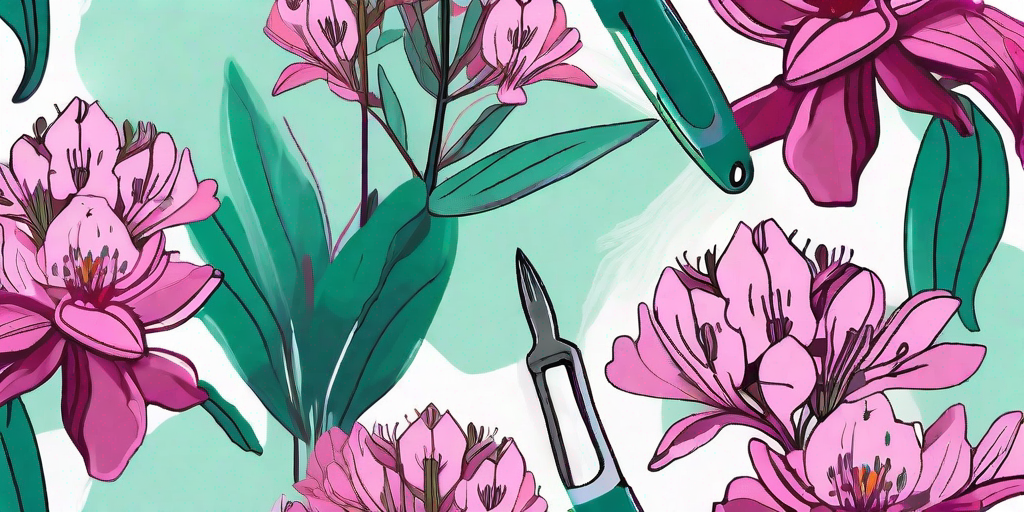
Rhododendrons, the divas of the garden, are known for their vibrant blooms and lush foliage. But don't let their high-maintenance reputation intimidate you. With a little bit of knowledge and a dash of cheeky humor, you'll be the envy of the neighborhood with your thriving rhododendrons. Let's dive in, shall we?
Understanding Rhododendrons
First things first, let's get to know our star plant a little better. Rhododendrons belong to the Ericaceae family, which also includes azaleas. They are native to Asia, North America, and Europe. They are known for their large, showy flowers and evergreen leaves. But enough of the botany lesson, let's get to the juicy stuff.
There are over a thousand species of rhododendrons, ranging from ground-hugging dwarf shrubs to towering trees. But don't worry, we won't be covering all thousand species today. We'll focus on the most common types that are perfect for beginners.
The Common Rhododendron Species
The most common species include the Catawba Rhododendron, the Pacific Rhododendron, and the Great Laurel. These are all hardy species that can withstand a variety of climates. They are also quite forgiving to beginner gardeners, which is always a plus.
Now that we've got the introductions out of the way, let's move on to the care and keeping of these beauties.
Caring for Your Rhododendrons
Contrary to popular belief, rhododendrons are not as high-maintenance as they seem. They just need a little bit of TLC and they'll reward you with stunning blooms. Here's how to keep your rhododendrons happy and healthy.
Choosing the Right Location
Like a diva choosing her dressing room, rhododendrons are particular about their location. They prefer a spot with dappled sunlight and well-drained soil. They also appreciate a bit of shelter from the wind. So, choose a location that meets these criteria and your rhododendrons will be singing your praises.
But what if your garden doesn't have the perfect spot? Fear not, rhododendrons can also be grown in containers. Just make sure to choose a large enough container and a well-draining potting mix.
Watering and Feeding
When it comes to watering, rhododendrons prefer a 'Goldilocks' approach – not too much, not too little, but just right. Overwatering can lead to root rot, while underwatering can cause wilting. So, aim for consistently moist soil.
As for feeding, rhododendrons prefer a slow-release, acid-forming fertilizer. Apply it in the early spring, just before the new growth starts. But remember, less is more when it comes to fertilizer. Too much can burn the roots and lead to a sad, droopy plant.
Common Problems and Solutions
Even with the best care, rhododendrons can sometimes run into problems. But don't panic, most issues can be easily resolved with a bit of know-how.
Yellowing Leaves
If your rhododendron's leaves are turning yellow, it could be a sign of chlorosis, a condition caused by a lack of iron. This can be easily fixed by applying an iron-rich fertilizer or by adding iron chelates to the soil.
Yellowing leaves can also be a sign of overwatering. If the leaves are yellow and wilted, it's time to cut back on the watering.
Brown Spots on Leaves
Brown spots on the leaves can be a sign of a fungal infection. This can be treated with a fungicide. However, prevention is better than cure. Make sure to water your rhododendrons at the base and avoid wetting the leaves to prevent fungal infections.
Now that we've covered the basics, let's move on to some frequently asked questions.
Frequently Asked Questions
- When is the best time to plant rhododendrons?
The best time to plant rhododendrons is in the early spring or early fall. This gives the plant plenty of time to establish its roots before the harsh weather sets in.
- Can rhododendrons grow in full sun?
While rhododendrons can tolerate full sun, they prefer a spot with dappled sunlight. Too much direct sunlight can scorch the leaves and cause the flowers to fade.
- How often should I prune my rhododendrons?
Rhododendrons generally don't require a lot of pruning. However, if you want to shape your plant or control its size, the best time to prune is after the flowers have faded.
And there you have it, a comprehensive guide to caring for rhododendrons. With these tips in hand, you're well on your way to becoming a rhododendron whisperer. Happy gardening!















